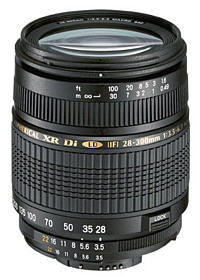
Tamron SP AF28-300/3.5-6.3 XR Di LD Aspherical (IF) Macro Review |
Tamron SP AF28-300/3.5-6.3 XR Di LD Aspherical (IF) Macro Review
I don't get no respect. One night I fell asleep with a cigarette in my hand - my wife lit it! - Rodney Dangerfield I dare say 28-300mm zooms feel the same way. They don't get no respect either! There seems to be a "knee jerk" reaction whenever they are mentioned on photo forums. No sooner does someone ask about one than the disparaging remarks start up. So does the Tamron 28-300 deserved respect? Read on to find out. SpecificationsThe Tamron SP AF28-300/3.5-6.3 XR Di LD Aspherical (IF) Macro is a general purpose lens for both digital and film cameras. On a film camera the 28-300mm range covers everything from landscapes through portraits to wildlife. On a typical APS-C digital camera, such as the Canon EOS 20D, it has the same field of view as a 45-480mm lens would on a full frame 35mm camera. The Tamron SP AF28-300/3.5-6.3 XR Di LD Aspherical (IF) Macro is a Tamron "Di" lens. Di lenses designed with digital SLRs in mind and Tamron say that they have higher resolution, better control of flare and ghosting, less light fall-off and lower chromatic aberration than earlier designs. Note that the Tamron SP AF28-300/3.5-6.3 XR Di LD Aspherical (IF) Macro lens, although designated as digital ("Di") has full frame 35mm coverage. It can be used both on APS-C sensor DSLRs and on full frame digital or film cameras. The Tamron SP AF28-300/3.5-6.3 XR Di LD Aspherical (IF) Macro is remarkably small and light for a 28-300mm lens. In fact Tamron state that it's currently the world's smallest and lightest 28-300mm zoom, and as far as I know they're right!
The lens solidly constructed with a low reflectivity black finish and a rubberized zoom control. The barrel extends in two sections as can be seen from the illustration below. Though the extension is about 80mm (3"), there is very little sideways play, which is commendable. The zoom can be locked in the 28mm position so that the lens doesn't extend when being carried in a downwards position. Focus can be switched between AF and MF with a small switch on the left, near the lens mount. Manual focus is smooth with about a 50 degree rotation of the rubberized focus ring from 0.49m to infinity. This means focus can be adjusted rapidly, but fine focus adjustments need a light touch. There is no depth of field scale and no IR focus identification mark. It's marked with focal lengths of 28, 35, 50, 70, 100, 135, 200 and 300mm Indicated maximum aperture at 300mm was f6.3, at 200mm f5.6, at 100mm f5, at 70mm f4.5, at 50mm f4, at 35mm f3.5 and at 28mm f3.5 The lens extends when zoomed (from around 84mm long at 28mm to around 164mm long at 300mm), but does not change length on focusing (it's internal focus - IF) and the front of the barrel does not rotate when the lens is zoomed or focused. However the focus ring does spin during autofocus, so keep your fingers away from it.
The Tamron SP AF28-300/3.5-6.3 XR Di LD Aspherical (IF) Macro uses four types of special optical elements as shown above. Three hybrid aspherical elements and two high-grade LD (Low Dispersion) glass elements are used to to lower spherical and chromatic aberrations. Additionally one of the elements is an AD-Hybrid aspherical element using AD (Anomalous Dispersion) glass with an aspherical coating. XR glass (extra refraction) is glass of high refractive index and is used to keep the lens short. The lens has a close focus distance of 0.49m (subject to sensor plane) which gives a maximum magnification of 1:2.9 at 300mm. Actually at the 300mm setting, the minimum distance between the front of the lens and the subject is only about 0.25m (10"). It should be noted that the focal length of most zooms of this type shorten significantly when close focused. Of course this doesn't really matter, it's the final magnification ratio that counts. Although the official name of the lens includes the term "macro" (at least that's what it says on the box), it's really more accurately described as "close focusing". True macro lenses usually give 1:2 or 1:1 magnification and are specially optically corrected to ensure low distortion, flat field and high sharpness at very close focus distances. A bayonet fitting "petal" style lens hood is supplied with the lens. Obviously it suffers from the same problem as lens hoods do on any wide range zoom. If it's wide enough not to vignette at the wide end of the zoom range, it won't be very efficient at the telephoto end. However any hood is better than no hood, and at least Tamron don't make you pay extra for it! Note that when mounted on an APS-C sensor DSLR like the Canon EOS 20D, the Tamron SP AF28-300/3.5-6.3 XR Di LD Aspherical (IF) Macro gives the same angle of view as a 45-480mm lens would on a full frame 35mm camera. NEXT: Part II - Performance Testing; Focal length, Aperture, 300mm, 200mm and 100mm performance
© Copyright Bob Atkins All Rights Reserved |
|||||||||||||||||||||||||||||||

